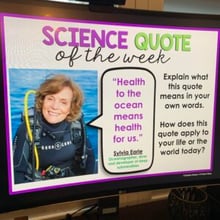Visible Light Activities for Middle School Science
The resources below will provide students a comprehensive understanding of visible light. All of the following lessons are also included in the Kesler Science Membership.
The Visible Light 5E Lesson includes materials for every "E" phase, including the Visible Light Station Lab for Exploration and an interactive PowerPoint with digital INB templates for Explanation.
The lesson also includes introduction materials for Engagement, student-choice project ideas for Elaboration, and assessments for Evaluation.
After completing the Visible Light 5E Lesson, students will be able to describe how light falls on the electromagnetic spectrum, how light determines color and brightness, and how an item's properties affect the way light is reflected, absorbed, or transmitted.
Explories - A Complete NGSS Storyline
Explories are NGSS units that integrate a storyline and project-based learning with Kesler Science Inquiry Labs, Station Labs, and 5E Lessons. The Explories unit below is also included in the Kesler Science Membership .

DARK: An NGSS Unit Study of the Sky
Welcome to DARK. This is an NGSS unit that integrates a storyline and projects with existing Kesler Science inquiry labs, station labs, and 5E Lessons. In this unit, students will join and assist the fictitious Amateur Astronomers’ Conservation Society, exploring the relationships between the Sun, Moon, and Earth, and evaluating changes that will affect our future atmosphere."Think about the sky for a moment. Do you picture a clear blue day with white puffy clouds? Or a nighttime view full of sparkling stars? Have you ever really thought about the importance of our sky?
You're in luck! You've been given a chance to 'expand your horizons.' Your class has been invited to join the Amateur Astronomers’ Conservation Society.
To complete your membership, you will first complete a specialized model of the Sun, Earth, and Moon’s relationship in space. Then, once you are a full member, you will help other members of the society investigate eclipses, reduce nighttime light pollution, and study the effects of atmospheric changes on our environment.
You're about to experience the sky in a whole new way.
Don’t be afraid of the DARK!"
Year-Round Resources
These year-round activities will increase your students' understanding of many middle school science topics. All of these activities are also included in the Kesler Science Membership.
Visual Data & Graphing
You're not alone if your students struggle with understanding graphs, charts, and tables. It's a skill that takes an enormous amount of practice. This resource will help students build a strong foundation in analyzing data and creating their own data visualizations.
Bell Ringers and Warm-Ups
These middle school science bell ringers are an excellent way to engage your students as soon as they walk into your classroom. This comprehensive FULL YEAR resource includes everything you need to start off each science class with an interesting warm-up activity.
Review Board Games
Each game board has been carefully designed to keep students engaged. There are 10 different action spaces on each board and dozens of question cards. All of the actions are related to science concepts and keep the students motivated throughout the game.
Each game is ready to play. Simply print out the board and the cards and let the students enjoy reviewing nine different units.
Essential Questions and Standards
Below are the essential questions and standards associated with the lessons and activities included in the visible light unit. This topic is only one of more than 100 middle school science topics included in the Kesler Science Membership.
-
Where does visible light fall on the electromagnetic spectrum?
-
How does an object's material and light's frequency (color) affect the way light is reflected, absorbed, or transmitted?
-
How does the frequency of a light wave determine the color?
-
How do primary colors of light produce secondary and complementary colors?
-
How does amplitude of a light wave determine brightness?
-
TEKS Science 8.8 C - Identify how different wavelengths of the electromagnetic spectrum such as visible light and radio waves are used to gain information about components in the universe
Kesler Science Membership
Imagine never having to search for another middle school science lesson again. The membership gives you access to ALL of the Kesler Science products in one place (Yes, including everything above).
Say goodbye to long hours of lesson prep.

